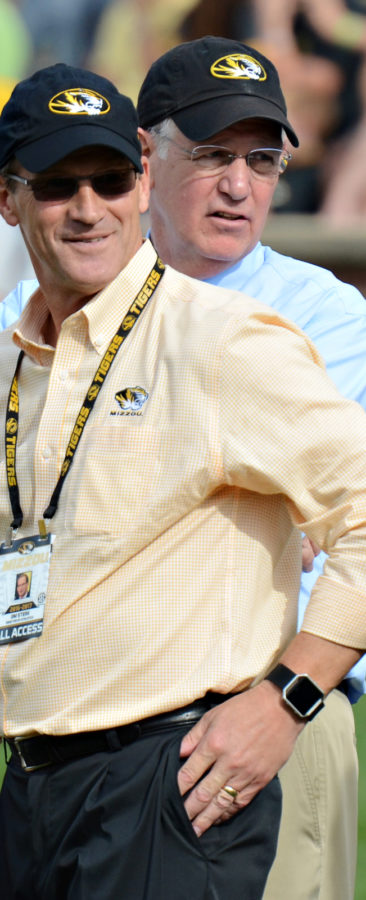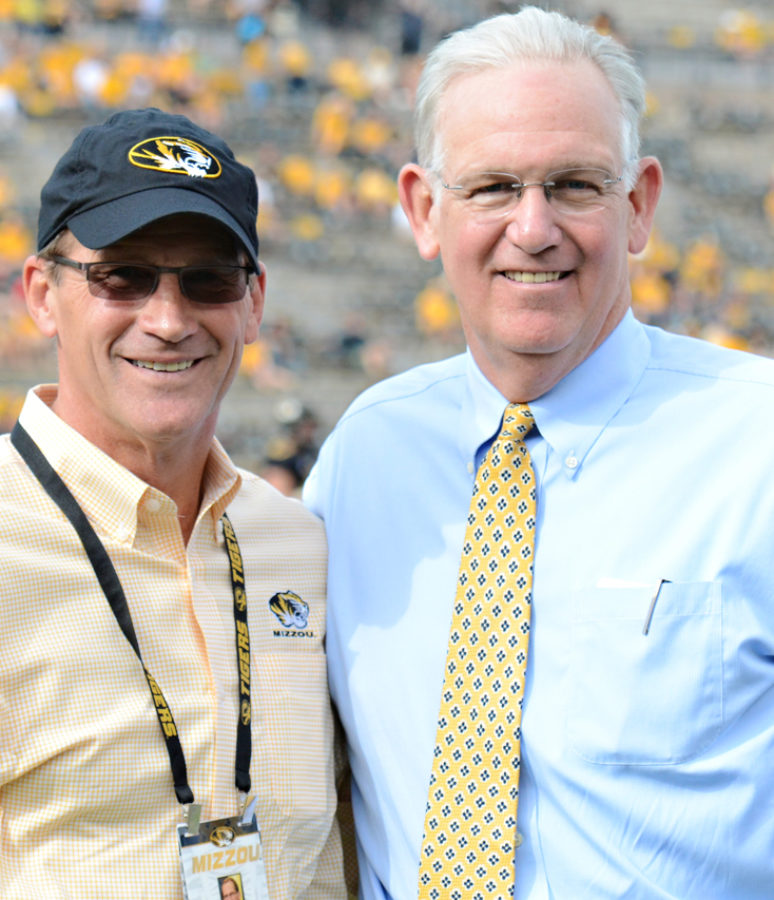Under Construction
In a matter of weeks, Jim Sterk accepted two of the top five largest donations in program history. But the new athletic director understands that just as critical to his job are the efforts to repair a University’s image and a program’s reputation.
Jim Sterk never saw it coming. Todd Turner of the search firm Collegiate Sports Associates was on the other end of the line, reaching out to gauge Sterk’s interest in the vacant athletic director position at the University of Missouri.
For more than six years, Sterk had served in the same capacity at San Diego State, having helped take the Aztecs to new heights while exploring the viability of getting the school into a Power Five conference. He was 60, a man with West Coast roots and no history of jumping from job to job. “My wife and I were not looking to leave San Diego,” Sterk told me in a recent telephone interview. “I don’t think anyone is looking to leave San Diego. I felt like I was on vacation after six and a half years — I wake up every morning and there are palm trees in my backyard.”
Understandably, the last place to which Sterk could have envisioned himself relocating was Columbia, Missouri. The university had an interim president and an interim chancellor and was just nine months removed from a student protest over perceived racism, a demonstration that shook the campus to its core after players on the football team threw their support behind it. A Title IX investigation into the behavior of softball coach Ehren Earleywine had dragged on for months, and the AD job was open only because Mack Rhoades bolted for Baylor after only 14 months in the position. Baylor wasn’t without its issues, and outsiders conjectured that Rhoades’s departure was an indication of how dire the situation was at Mizzou.
But the more he talked with Turner, the more curious Sterk became about the position. “As we dug into it, it intrigued me more and more,” he says.
He and his wife, Debi, liked the idea of living in a college town that had so much to offer. In fact, Columbia reminded Sterk of Pullman, Washington, the home of Washington State, where he served as AD from 2000-10.
“Pullman on steroids,” as he calls Columbia.
An AAU-accredited, land-grant university with medical and law schools was a draw. Then there was the athletic affiliation with the SEC. And for all of the talk of instability, the continuity in the athletics department could not be dismissed. Mike Alden, Rhoades’ predecessor, had served for 17 years. Gary Pinkel was on the sideline for 15 years, a remarkable feat in the high-pressure world of college football. The situation couldn’t be that bad, could it?
“Basically, the national public perception of Columbia wasn’t reality,” Sterk says. “I looked at it as an opportunity and a challenge to really help it move forward. How do you change the image and the brand? That got my juices flowing. Especially if it was as good a place as I thought.”
In the end, he decided it was. On August 11, Sterk was introduced as Mizzou’s new athletic director. At a morning press conference, he called the job a “destination spot,” adding, “I have no intention of leaving, so you’re stuck with me.”
His most pleasant surprise? “That the people are even better than advertised.” After the press conference, the line to welcome Debi was longer than his. “People were genuinely interested in meeting her and talking to her,” he says. Sterk shares the story of a visit he and Debi made to Columbia. They were getting out of their car in front of the Tiger Hotel when a stranger who happened to be walking by collected her luggage and hustled it inside. “In California, you sometimes have to worry that [the luggage] would be gone,” he quips.
Sterk’s opportunity doesn’t come without baggage — among other things, he will commission an outside party to help amp up ticket sales for football, and he will closely monitor the progress shown by the men’s basketball team under third-year coach Kim Anderson — but his first order of business was to talk to as many of his colleagues as possible. First up: Barry Odom, in a meeting that came shortly after the press conference. Put yourself in Odom’s shoes. He’s 39, three weeks from making his head coaching debut. The guy who hired him had left abruptly, breaking the news of his departure the night before Odom was to appear at the circus that is SEC Media Days. Now the new boss wanted a word.
Turns out that Sterk didn’t want to talk as much as he wanted to listen. It’s a recurring story: He wants to know what you think. It’s an admirable quality that has helped make the man a success, developed over a three-decade career in athletics administration that has spanned from coast to coast. In independent conversations, SEC commissioner Greg Sankey and his predecessor Mike Slive both told Sterk that Mizzou’s facilities were severely lacking compared with those of almost all other schools in the conference. Now, Sterk was getting a first-hand look with Odom filling the role of tour guide. It had been a whirlwind morning for the new AD; nevertheless, the coach had his undivided attention.
“I felt sorry for him when he got to our facility,” Odom says. “I could tell he’d had a long day already. I knew what was on my list, and we walked and talked. The number one thing we agreed on is that we have to have facilities that are competitive for us to win a championship. And we’re going to have facilities that allow our student-athletes to be successful in every area, from sports medicine to our academic resource center to our weight room to our dining hall to our meeting spaces. Then you have to put yourself in the shoes of your student-athletes on how it fits in the day-to-day operation. When you’re dealing with 540 student-athletes, you want to make sure every one of them has what they need to be successful.”
At the top of Odom’s wish list was a football facility at the south end of Faurot Field. It was an idea first broached by Pinkel and a project that has been discussed for years. But when he arrived in April 2015, Rhoades had made it clear that he preferred a facility that catered to athletes in all sports. Sterk had talked by phone regularly with Odom, even before they were formally introduced, and got on board quickly with the original plan. Odom has been impressed every step of the way.
“He’s never been the guy who walks into the room and says, ‘Look at me,’” Odom says. “He’s going to work extremely hard, and he’s going to treat people right. There’s no question who’s in control of the meeting, but he’s a great listener.”
A couple of hours before making that observation to me, Odom had attended the weekly head coaches’ meeting that Sterk convenes. The session typically lasts an hour, and on this day, the athletic director spent almost the entire time taking notes, listening to his coaches and gathering material so he’ll be prepared to make informed decisions. He is nothing if not thorough. Odom, for one, likes his demeanor and his management style.
“It’s been fun to start to solve problems with him,” the head coach says.
If he had been taking notes about Odom, Sterk couldn’t have been blamed had he scribbled down why someone with no college head-coaching experience was handed the keys to a Power Five program in the sport’s toughest conference. But he has been nothing but impressed with Odom and his vision for rebuilding a successful football program.
“He’s a great one,” Sterk says. “He’s a really, really good fit for here; he has a passion. Everything he does: How can we move one step closer to winning that national title? I want to help him do that. My job is to facilitate and make that happen.”
So, he’s rolled up his sleeves and gone to work, meeting alumni and friends of the university and officials around the state. In a matter of weeks, Sterk has accepted anonymous donations of $10 million and $8 million; they represent two of the top five donations in program history. More contributions are on the way. The plan is to complete the project in three phases: the construction of the south end-zone complex, the addition of a 100-yard indoor facility, and the retrofitting of the Missouri Athletic Training Complex. The first phase comes with an estimated $75-80 million price tag. And in addition to the football facility, it will include structural stadium work, restrooms and concessions, and the potential to add premium seating. “Guys in the apartment business say that if you’re 90 percent occupied, it’s a good time to build,” Sterk says. Capacity on the premium seating added in 2014 as part of the east side renovation is at 97 percent.
So, build he will. Mizzou is working on a master plan with Kansas City-based HOK — a design, architecture, building and planning firm — who will help select an architect to handle the project. A procedural presentation was made at the Board of Curators meeting on October 6, and ideally, Sterk will get final approval when the board convenes again in February 2017.
“It’s going to be a football building, but it’s going to benefit our entire athletics program because it frees up the crowded space we had in the MATC as far as weight room, medical training and equipment room,” Sterk says. The MATC, he notes, has outgrown its purpose. “It’s been trying to solve everything for everybody.”
Locker rooms are all the rage among players and recruits, and Mizzou intends to do everything it can to keep up with the Joneses. Sterk has encouraged Odom to identify “what are the best ones out there and why?” — not only in locker rooms but also in overall facilities. Throughout his tenure, Pinkel trumpeted the need for first-class facilities to be successful — “If you don’t see cranes up, something’s wrong,” he would say.
Well, the cranes are coming, and Pinkel is happily involved. No timetable has been set for the completion of the first phase, but Sterk knows that time is of the essence.
“It’s a positive urgency,” he says. “You can’t be behind the times, per se, in facilities and compete at the highest level. This is one of, if not the most competitive football league in the country. We need to be comparable and do it our way — the Mizzou way — and make it unique and attractive and inviting.”
But brick and mortar can carry you only so far. Sterk understands that doing his part to repair a university’s image and rebrand an athletic department will be every bit as critical as the money he raises and the construction projects he oversees. He reflects on a conversation with A.J. Ofodile, a kid from Detroit who played for the Tigers and in the NFL, coached down the street at Rock Bridge High School, then returned to Missouri’s football program this year as Odom’s recruiting coordinator.
“He talked about how this was the most inclusive place he has ever lived,” Sterk says. “He was talking passionately about Mizzou and the great things it has to offer. That’s the message that we have to continue to get out there — what is truly the experience here. People from Missouri are “show-me.” They’re not trying to show off. I think part of it is coming out of the shell and being more proactive in telling the story about the things that are going on here. I’ve got to help everyone toot their own horns a little bit, because there are a lot of great things going on. Our student-athletes are having a great experience.”
Save for the lack of palm trees, Jim Sterk expects the same.
Mark Godich is a senior editor at Sports Illustrated and the author of the 2013 book, Tigers vs Jayhawks: From the Civil War to the Battle for No. 1.
Photos: Nicholas Mebruer | MebruerActionPhotography.com



